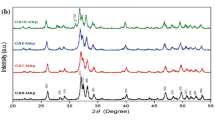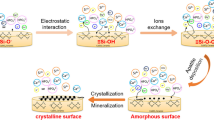Abstract
Apatite formation on CaSiO3 ceramics was investigated using two different simulated body fluids (SBF) proposed by Kokubo (1990) and Tas (2000) and three sample/SBF (S/S) ratios (1.0, 2.5 and 8.3 mg/ml) at 36.5°C for 1–25 days. The CaSiO3 ceramic was prepared by firing coprecipitated gel with Ca/Si = 0.91 at 1400°C. The bulk density was 2.14 g/cm3 and the relative density about 76%. The two SBF solutions contain different concentrations of HCO3− and Cl− ions, the concentrations of which are closer to human blood plasma in the Tas SBF formulation than in the Kokubo formulation. The pH values in the former solution are also more realistic. The CaSiO3 ceramics show apatite formation in SBF (Kokubo) after soaking for only 1 day at all S/S ratios whereas different phases were formed at each S/S ratio in SBF (Tas). The crystalline phases formed were mainly apatite at S/S = 1.0 mg/ml, carbonate-type apatite at 2.5 mg/ml and calcite at 8.3 mg/ml. At higher S/S ratios the increase in the Ca concentration became higher while the P concentration became lower in the reacted SBF. These changes in SBF concentrations and increasing pH occurred at higher S/S ratios, producing more favorable conditions in the SBF for the formation of carbonate bearing phases, finally leading to the formation of calcite instead of apatite in the higher HCO −3 ion concentration SBF (Tas). Apatite is, however, formed in the lower HCO −3 ion concentration SBF (Kokubo) even though the Ca and P concentrations change in a similar manner to SBF (Tas).
Similar content being viewed by others
References
T. KOKUBO, J. Non-Cryst. Solids 120 (1990) 138.
L. L. HENCH, J. Amer. Ceram. Soc. 74 (1991) 1487.
H. AOKI, Medical Applications of Hydroxyapatite, Ishiyaku Euro America, Tokyo, 1994.
J. D. SANTOS, L. J. JHA and F. J. MONTEIRO, J. Mater. Sci. Mat. Med. 7 (1996) 181.
S. FALAIZE, S. RADIN and P. DUCHEYNE, J. Amer. Ceram. Soc. 82 (1999) 969.
S. HAYASHI, K. OKADA and N. OTSUKA, J. Ceram. Soc. Jpn. 99 (1991) 1224.
P. SIRIPHANNON, Y. KAMESHIMA, A. YASUMORI, K. OKADA and S. HAYASHI, J. Biomed. Mat. Res. 52 (2000) 30.
S. B. CHO, F. MIYAJI, T. KOKUBO, K. NAKANISHI, N. SOGA and T. NAKAMURA, J Biomed. Mat. Res. 32 (1996) 375.
K. OKADA, P. SIRIPHANNON, Y. KAMESHIMA and S. HAYASHI, Trans. Mat. Res. Soc. Jpn 29(6) (2004) 2891.
Y. IIMORI, Y. KAMESHIMA, A. YASUMORI and K. OKADA, J. Mater. Sci. Mat. Med. 15(11) (2004) 1247.
A. C. TAS, Biomaterials 21 (2000) 1429.
M. VALLET-REGI, A. M. ROMERO, V. RAGEL and R. Z. LEGEROS, J. Biomed. Mat. Res. 44 (1999) 416.
M. VALLET-REGI, D. ARCOS and J. PEREZ-PARIENTE, J. Biomed. Mat. Res. 51 (2000) 23.
Author information
Authors and Affiliations
Rights and permissions
About this article
Cite this article
Iimori, Y., Kameshima, Y., Okada, K. et al. Comparative study of apatite formation on CaSiO3 ceramics in simulated body fluids with different carbonate concentrations. J Mater Sci: Mater Med 16, 73–79 (2005). https://doi.org/10.1007/s10856-005-6449-x
Received:
Accepted:
Issue Date:
DOI: https://doi.org/10.1007/s10856-005-6449-x




